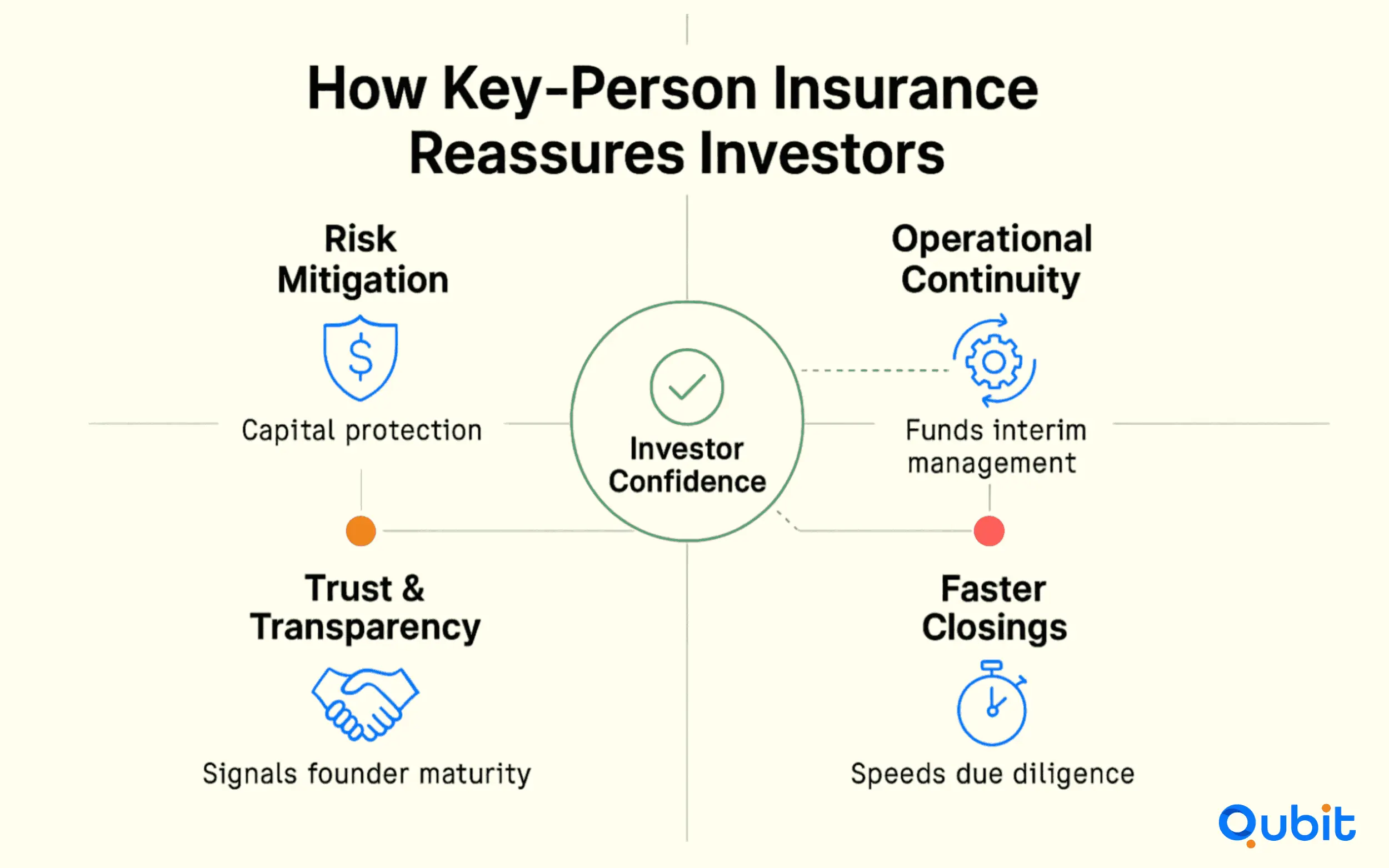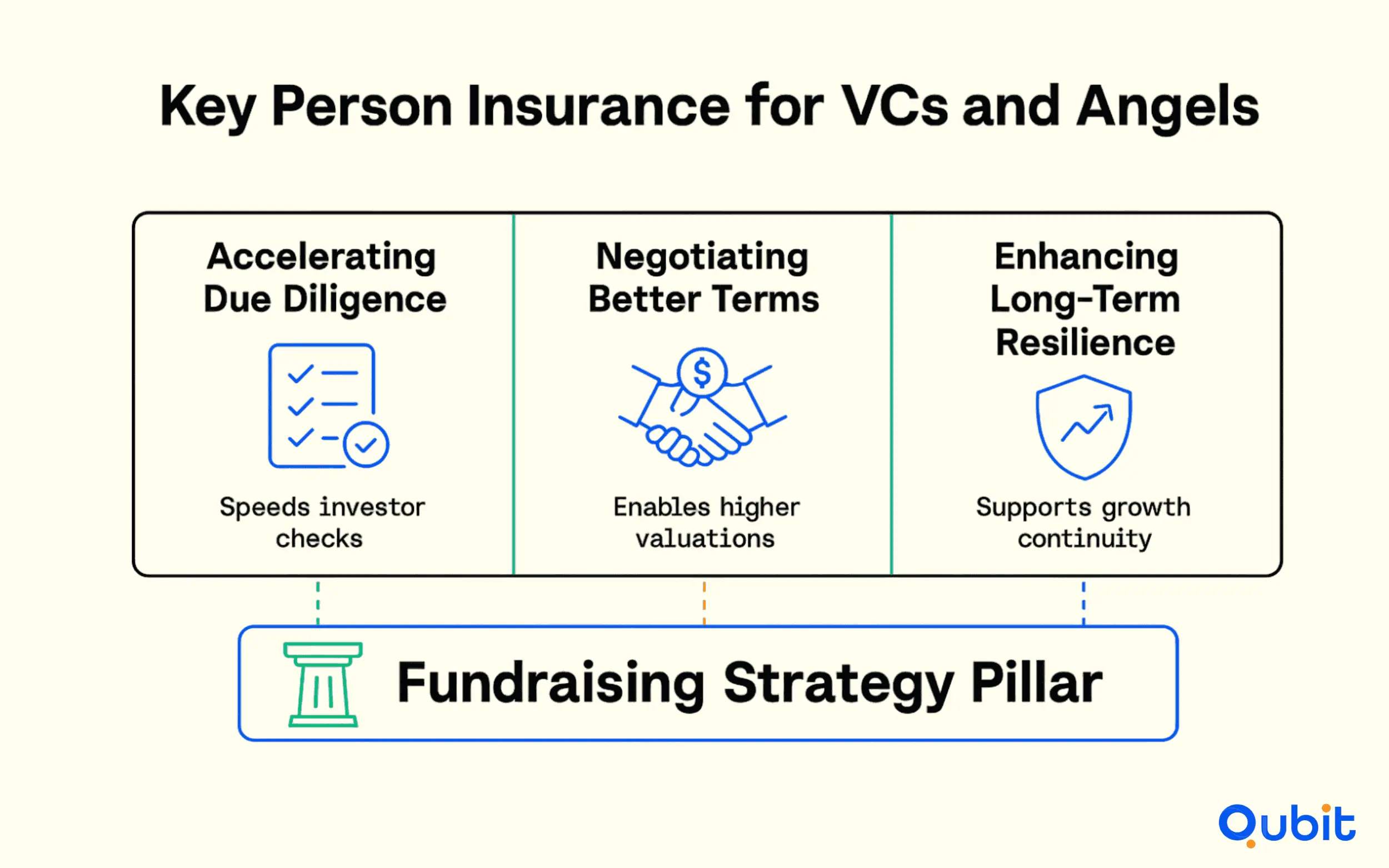Securing venture capital or angel investment often hinges on mitigating risks that could jeopardize a startup’s success. Key-person insurance plays a pivotal role in this equation, offering a safety net that reassures investors about the continuity of leadership and expertise. This specialized insurance protects businesses against financial losses stemming from the sudden absence of a critical team member, such as a founder or executive.
The discussion in insurance startup fundraising strategies presents a broader context where key-person insurance is positioned as part of an integrated risk management framework, helping you see its relevance in securing support for insurance start-ups. By addressing concerns about leadership stability, this coverage becomes a compelling tool for attracting venture capital and angel investors.
What Is Key-Person Insurance?
Key-person insurance is a life or disability insurance policy purchased by a company on the life of a founder or other critical executive. If the insured individual dies or becomes disabled, the company receives a payout that can be used to:
- Cover lost revenue or profits
- Fund the search and onboarding of a replacement
- Satisfy investor covenants
- Maintain business continuity during a transition
Modern key-person insurance can also be tailored to cover alternative risks, such as the loss of intellectual property, key client relationships, or regulatory standing—making it especially relevant for insurtech startups with unique business models.
Why Key-Person Insurance Matters for Insurance Startups
The Investor Perspective
Insurance startups operate in a sector where trust, compliance, and continuity are paramount. VCs and angels, who often back early-stage companies with unproven business models, are acutely aware of the risks associated with founder or executive loss. In insurance, where regulatory knowledge, proprietary technology, and industry relationships are often concentrated in a few key individuals, this risk is heightened.
Key-person insurance provides a financial safety net that reassures investors their capital is protected if a critical leader is lost. For many institutional investors, it is not just a preference but a standard requirement before closing a funding round. More than 80% of funding agreements in the sector now include a key-person insurance clause, reflecting its central role in due diligence and risk management.
For a deeper understanding of how key person insurance complements other coverage types, explore our article on directors officers insurance investors, which delves into layered risk mitigation strategies.
How Key-Person Insurance Reassures VCs and Angels

1. Risk Mitigation and Capital Protection
Investors want to know their capital is safe from unforeseeable events. Key-person insurance provides a clear, quantifiable risk mitigation mechanism, reducing the likelihood that a leadership crisis will turn into a financial disaster.
2. Operational Continuity
A payout from a key-person policy can fund interim management, executive searches, or operational adjustments, ensuring the company stays on track even after a major disruption. This continuity is especially important in insurance, where regulatory deadlines and customer obligations cannot be missed.
3. Trust and Transparency
By proactively securing key-person insurance, founders signal to investors that they understand and are prepared for the realities of risk management. This builds trust and demonstrates a mature, responsible approach to business—qualities that VCs and angels value highly.
4. Smoother Due Diligence and Faster Closings
Having key-person insurance in place can expedite the due diligence process, reduce negotiation friction, and even improve the company’s valuation by lowering perceived risk. Many investors now include key-person insurance as a checklist item before wiring funds.
Use credibility checklist for insurance startups to anticipate the questions that decide outcomes.
Identifying Who Needs Coverage
Not every team member is a “key person.” For insurance startups, the following roles are typically considered essential:
- Founders and Co-Founders: Especially those with regulatory, technical, or industry expertise.
- Chief Technology Officer (CTO): If the company’s value proposition is built on proprietary technology.
- Chief Compliance Officer: In regulated markets, compliance leadership is critical.
- Head of Distribution or Partnerships: If customer acquisition relies heavily on industry relationships.
Assessing the impact of losing each individual—on revenue, compliance, and operations—will help determine who should be covered.
Another effective method is analyzing how critical roles intersect with risk management strategies. For example, safeguarding essential positions aligns with principles discussed in product liability insurance investor capital, where protecting assets during product launches mirrors the importance of securing high-impact personnel.
Determining Coverage Amounts
The right coverage amount should reflect the financial impact of losing a key person. Consider:
- Revenue Contribution: How much business or revenue is directly tied to the individual?
- Replacement Costs: What will it cost to recruit, hire, and onboard a replacement?
- Business Disruption: How long would it take to recover, and what losses might accrue during that period?
- Investor Requirements: Many investors specify minimum coverage amounts in term sheets.
Tip: Use specialized calculators or consult with brokers experienced in insurtech to arrive at a realistic figure.
The Procurement Process: How Insurance Startups Can Secure Key-Person Coverage
Step 1: Prepare Documentation
Gather detailed bios of insured individuals, company financials, and a cover letter explaining your vision, business model, and risk management approach. This information will streamline underwriting and demonstrate professionalism to both insurers and investors.
Step 2: Consult Experienced Brokers
Work with insurance brokers who understand the insurtech landscape. They can help you identify the right policy structure, coverage limits, and additional riders (such as disability or loss of license).
Step 3: Compare Quotes and Terms
Solicit quotes from multiple providers, comparing not just price but also exclusions, payout terms, and the insurer’s reputation for claims handling.
Step 4: Finalize and Communicate
Once the policy is in place, include details in your pitch deck, due diligence materials, and investor communications. Proactively addressing this topic reassures investors and can accelerate the funding process.
Example: Key-Person Insurance in Action
Consider the case of a Series A insurtech startup developing a proprietary AI underwriting platform. The CTO, who designed the core algorithm, was recognized as a key person by both the board and prospective investors. During funding negotiations, VCs insisted on a key-person policy that would cover the cost of hiring a replacement and the potential delay in product rollout if the CTO were lost. By securing a policy and including it in their due diligence packet, the startup not only satisfied investor requirements but also closed the round two weeks ahead of schedule—demonstrating the practical value of this coverage.
At Qubit Capital, we understand the unique challenges startups face during fundraising. If you’re ready to secure the right coverage and strengthen your investor relationships, explore our Fundraising Assistance service. Let us help you take the next step toward sustainable growth.
Common Mistakes to Avoid When Presenting Key-Person Coverage
According to industry experts, insurance startup founders often make the following errors when discussing key-person insurance with investors:
- Underestimating Regulatory Impact: Failing to show how leadership loss could affect compliance or licensing.
- Generic Coverage: Opting for off-the-shelf policies that do not address the unique risks of your business model.
- Lack of Documentation: Not including policy details in investor materials or failing to update coverage as the company grows.
- Overlooking Disability: Focusing only on life insurance and ignoring disability, which is often a more likely risk.
Avoiding these pitfalls will help you present a credible, investor-ready risk management plan.
This streamlined approach not only simplifies the procurement process but also ensures that businesses are adequately protected against the financial risks associated with losing a critical team member.
Key Person Insurance for VCs and Angels
Key person insurance has become a cornerThe Role of Key-Person Insurance in Fundraising Strategy

Accelerating Due Diligence
Investors are increasingly sophisticated in their approach to risk. Having key-person insurance in place can dramatically speed up the due diligence process, as it checks a major box on most investor checklists.
Negotiating Better Terms
Startups that proactively address investor concerns, by securing key-person insurance and integrating it into their broader assurance strategy, are often able to negotiate better funding terms, including higher valuations and more favorable covenants.
Enhancing Long-Term Resilience
Beyond fundraising, key-person insurance strengthens your company’s operational resilience, ensuring you can navigate unexpected challenges without derailing growth or damaging investor relationships.
Key-Person Insurance and the Future of Insurtech Fundraising
The insurtech sector is experiencing a surge in funding, driven by advances in AI, embedded insurance, and digital distribution models. As competition intensifies, investors are looking for startups that combine technological innovation with robust risk management.
Conclusion
For insurance startup founders, key-person insurance is far more than a regulatory checkbox, it’s a strategic foundation for building investor trust and ensuring business resilience. By proactively securing and tailoring this coverage, you address one of the most significant concerns for VCs and angels: the risk of losing essential leadership. Integrating key-person insurance into your broader risk management and fundraising strategy not only streamlines due diligence but can also lead to better funding terms and long-term growth.
Strengthen that story with a raise plan built for your stage, deck, metrics, and targeted outreach. Explore our insurance fundraising services and turn diligence into momentum.
Key Takeaways
- Key-person insurance is essential for insurance startups seeking VC or angel investment. It directly addresses one of the top investor concerns: the risk of losing a founder or key executive.
- Coverage should be tailored to your startup’s unique risks, including regulatory, technical, and market dependencies.
- Integrate key-person insurance with broader investor assurance strategies, such as D&O and product liability insurance, to present a comprehensive risk management plan.
- Proactively communicate your coverage to investors. Include policy details in pitch decks, due diligence packets, and negotiations.
- Avoid common mistakes, such as generic coverage or lack of documentation, to maximize the impact of your key-person policy on fundraising outcomes.
Frequently asked Questions
What is key person insurance?
Key person insurance is a specialized life insurance policy that safeguards businesses against the financial consequences of losing a pivotal employee. This coverage ensures operational stability during unforeseen circumstances, allowing companies to focus on recovery rather than financial strain.






